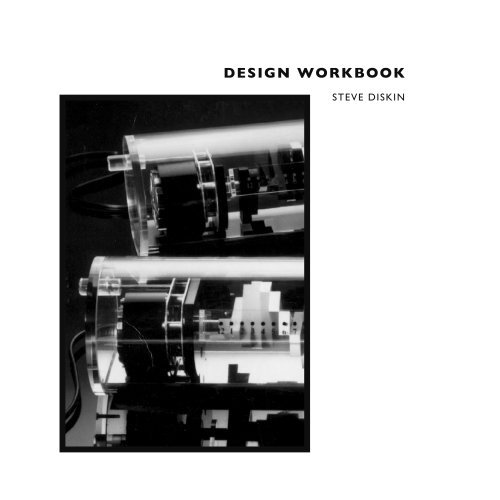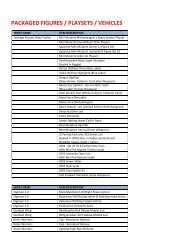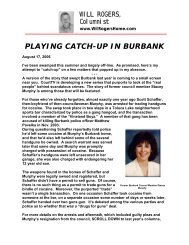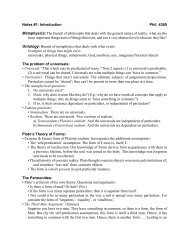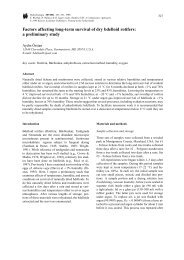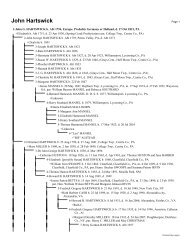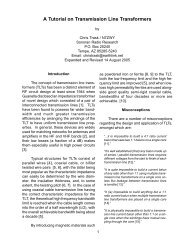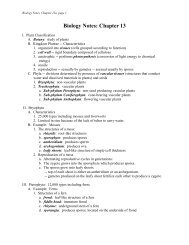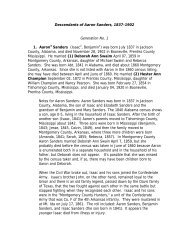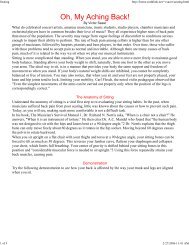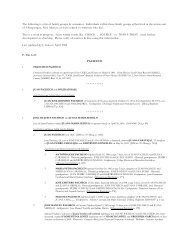design workbook
design workbook
design workbook
You also want an ePaper? Increase the reach of your titles
YUMPU automatically turns print PDFs into web optimized ePapers that Google loves.
DESIGN WORKBOOK<br />
STEVE DISKIN
Printed in the Czech Republic<br />
All Rights Reserved<br />
© Steve Diskin, 2005<br />
DESIGN WORKBOOK<br />
STEVE DISKIN
4<br />
Steve Diskin was awarded a BA, magna cum<br />
laude, in Visual Studies (Architectural Sciences)<br />
in 1970, as well as a Masters in Architecture at<br />
Harvard University in 1974. He joined Kenzo<br />
Tange + URTEC in Tokyo, where he participated<br />
in many international architectural projects. His<br />
career expanded with the <strong>design</strong> of his HELIX<br />
clock (now in the permanent collection of the<br />
National Design Museum at the Cooper-Hewitt<br />
in New York), which uses the rotational and linear<br />
characteristics of the spiral for a dramatic departure<br />
in time-telling. This led to the establishment of his<br />
industrial <strong>design</strong> and manufacturing company, Tik-<br />
Tek Engineering, in Los Angeles. He was invited<br />
into the Kovacs Design Group in New York in<br />
S T E V E D I S K I N<br />
1982, and his lamp series “Parallels” was later<br />
produced by Kovacs Lighting.<br />
Diskin <strong>design</strong>ed a futuristic chandelier for the<br />
entry of the Norfolk Airport Hilton Hotel, and<br />
during March-May 1986 he showed his work in<br />
a group show entitled “Sidecar: The Process of<br />
Design in Contemporary Lighting” at the Los<br />
Angeles Craft and Folk Art Museum.<br />
Steve Diskin was Executive Vice President of<br />
MEGA/ERG, a small, select team of <strong>design</strong>ers of<br />
office furniture and accessories. He has directed<br />
the efforts of the group in the <strong>design</strong> and<br />
prototyping of more than 25 projects, large and<br />
small, in the area of office furniture and accessory<br />
devices. In 1988 he authored the “Microsystem”<br />
modular furniture and space enclosure system.<br />
Mr. Diskin was featured in the New York Times in<br />
1983, in the Los Angeles Times in 1985, and again<br />
with MEGA/ERG in 1988.<br />
In addition to his professional work, from<br />
1989 to 2002, Steve Diskin was senior instructor<br />
in Advanced Product Design and Environmental<br />
Design, as well as co-coördinator of the graduate<br />
program in Industrial Design from 1998-2002, at<br />
Art Center College in Pasadena, CA, where he was<br />
voted “Great Teacher” thirteen times. His work at<br />
Art Center has been the subject of articles in the<br />
Los Angeles Times, the Los Angeles Business Journal,<br />
Progressive Architecture and Popular Science.<br />
He has previously been on the faculty of the<br />
Harvard University Graduate School of Design in<br />
the summer Professional Development Program<br />
(1995-2001) and has lectured at the Academy of<br />
D E S I G N W O R K B O O K<br />
Fine Arts in Warsaw, Istanbul Technical University,<br />
Acer Computer in Taiwan, The Institute for<br />
Industrial Design in Oslo, LEGO in Denmark,<br />
New Balance in Massachusetts, IMD International<br />
in Lausanne and the HGKZ in Zurich, as well<br />
as other universities and academies of <strong>design</strong> in<br />
Europe.<br />
Diskin is the co-author of Los Angeles at 25<br />
MPH, a photographic excursion through LA’s<br />
rich residential architecture. He has also studied<br />
towards an advanced degree in film at Art Center,<br />
concentrating on digital video and documentary.<br />
His multi-media videos “Africa on My Mind”,<br />
“Four Friends: How Designers Think They Work”<br />
and “For Forty Years I Have Tried to Understand<br />
the Moon” won critical acclaim at the Industrial<br />
Designers Society Conferences in Detroit, 1994,<br />
Santa Fe, 1995, and Orlando, 1996. Diskin received<br />
an Art Center Digital Artist Grant in 2000.<br />
Steve Diskin is presently Visiting Professor<br />
at the Academy of Art Architecture and Design<br />
(VSUP) in Prague. He was visiting professor for<br />
two years at the University of Ljubljana, Slovenia,<br />
in the Academy of Fine Art and Design (ALU)<br />
and was simultaneously guest professor in the<br />
Department of Textiles, Faculty of Natural Sciences<br />
and Engineering, for the spring semester 2003.<br />
Steve has recently contributed articles to<br />
several Slovenia publications: Ambient (interior<br />
<strong>design</strong>), Adria Airways In-Flight Magazine, and the<br />
Saturday Supplement of the daily newspaper Delo.<br />
He is also the author and illustrator/writer of<br />
What a Totally Crazy Orchestra (Strune od Zemlje<br />
do Lune), a book about musical instruments<br />
for children published in 2004 by Vale/Novak in<br />
Ljubljana. The book was one of three nominated<br />
as Best Children’s Book of 2004 by the jury of the<br />
2004 Ljubljana Book Fair.<br />
In addition to his teaching and professional<br />
work, Diskin is pursuing his doctorate in<br />
architecture at EPFL (Ecole Polytechnique<br />
Federale de Lausanne) in Switzerland and is hard<br />
at work on his first book of fiction, Nomad Hotel.<br />
5
6<br />
S T E V E D I S K I N<br />
D E S I G N W O R K B O O K<br />
HELIX CLOCK<br />
The rotation of three helical elements (and the translation of<br />
rotational into linear motion) shows time at the intersection<br />
with the numbered index. Production: 1980-82, Kirsch-<br />
Hamilton Associates, Boston. Permanent collection of the<br />
National Design Museum (Cooper-Hewitt), New York.<br />
Published in Look of the Century, history of <strong>design</strong> from the<br />
permanaent collection of the museum, 1996<br />
58cm x 9cm<br />
7
8<br />
S T E V E D I S K I N<br />
D E S I G N W O R K B O O K<br />
9
10<br />
S T E V E D I S K I N<br />
D E S I G N W O R K B O O K<br />
OCTO AND TETRA<br />
High-tech, “industrial” table clocks using ABS plastic pipe<br />
connectors. Production by Tik-Tek Engineering, Los Angeles,<br />
1981-1985<br />
11cm diameter<br />
11
12<br />
S T E V E D I S K I N<br />
D E S I G N W O R K B O O K<br />
NOVA WALL CLOCK<br />
ABS plastic in black, white or gray with red, yellow and<br />
green indicators. Floating acylic lens. Production by Tik-Tek<br />
Engineering, Los Angeles, 1982-1986.<br />
27cm diameter<br />
13
14<br />
S T E V E D I S K I N<br />
D E S I G N W O R K B O O K<br />
TIME CAPSULE<br />
Reminiscent of a compass, Time Capsule tells time by the<br />
rotation of three concentric discs past a fixed indicator.<br />
Spun aluminum base with epoxy finish in black, red or<br />
white. Aluminum discs. Acrylic dome. Production by Tik-Tek<br />
Engineering, Los Angeles, 1983-1986.<br />
10cm diameter<br />
15
16<br />
S T E V E D I S K I N<br />
D E S I G N W O R K B O O K<br />
DISCUS AND ORB<br />
Both clocks use acylic and anodized aluminum components.<br />
Production by Tik-Tek Engineering, Los Angeles, 1984-1986.<br />
25cm diameter disc (Discus)<br />
15cm dome (Orb)<br />
17
18<br />
S T E V E D I S K I N<br />
D E S I G N W O R K B O O K<br />
DIGIT AND ALARM<br />
Digit features an anodized aluminum base to support a<br />
large size LCD display. Alarm is also a formed anodized<br />
aluminum structure with an acylic lens. Production by Tik-Tek<br />
Engineering, Los Angeles, 1985-1986.<br />
15cm height (Digit)<br />
9cm height (Alarm)<br />
19
20<br />
S T E V E D I S K I N<br />
D E S I G N W O R K B O O K<br />
DISKIN FOR KOVACS<br />
Clocks: Chopsticks, Good Heavens!, ClockLamp, A Head of<br />
Time. Production by Kovacs Design Group, New York, 1984-<br />
1986.<br />
30cm (Chopsticks table, wall), 100cm (floor)<br />
30cm diameter (Good Heavens!)<br />
40cm (ClockLamp) with compact fluorescent bulb<br />
28cm and 20cm (A Head of Time)<br />
21
22<br />
S T E V E D I S K I N<br />
D E S I G N W O R K B O O K<br />
PARALLELS AND 607 DESK LAMP<br />
Twin-tube compact fluorescent light source permitted a very<br />
thin profile for Parallels. 607 is a prototype. Production by<br />
George Kovacs Lighting, New Y2ork, 1985.<br />
30 cm height (Parallels Table and Wall), 90cm (floor)<br />
Adjustable height (607)<br />
23
24<br />
S T E V E D I S K I N<br />
D E S I G N W O R K B O O K<br />
MICROSYSTEM OFFICE<br />
Prototype for a blow-molded plastic office furniture system<br />
with extruded, snap-together modules. Preliminary license to<br />
Project Office, Ltd., London, 1989<br />
53cm x 53cm, 53cm x 87cm, 53cm x 106cm panel modules<br />
25
26<br />
S T E V E D I S K I N<br />
D E S I G N W O R K B O O K<br />
MACTABERNACLE<br />
Prototype for a mobile enclosure/workstation for the original<br />
Macintosh. Mega/Erg, Beverly Hills, 1987.<br />
136cm height<br />
27
28<br />
S T E V E D I S K I N<br />
D E S I G N W O R K B O O K<br />
BICUBIC DODECAHEDRON<br />
Full-scale prototype of a modular habitation structure using<br />
complex 3d stacking and repetition geometry. Plywood. Built<br />
on the campus of Art Center College of Design, Pasadena,<br />
1994<br />
125cm x 250cm panel module, 6.5m 2 floor area, 32m 3 volume<br />
29
30<br />
S T E V E D I S K I N<br />
D E S I G N W O R K B O O K<br />
THE BIRTH OF TEXTILES<br />
Sculpture for the atrium of the newly renovated City<br />
Museum of Ljubljana, showing historical and modern textile<br />
techniques (with Prof. Marija Jenko and ten students, Faculty<br />
of Textiles and Fashion, University of Ljubljana), Ljubljana,<br />
Slovenia, 2004<br />
250cm x 700cm<br />
31
32<br />
S T E V E D I S K I N<br />
D E S I G N W O R K B O O K<br />
LOS ANGELES AT 25MPH<br />
A photographic survey of some of LA’s lesser-known<br />
examples of residential architecture (with Joseph Giovannini,<br />
co-author). Publication by Van Nostrand Reinhold, New York,<br />
1993<br />
22cm x 28cm, 219 pages<br />
33
34<br />
S T E V E D I S K I N<br />
D E S I G N W O R K B O O K<br />
STRUNE OD ZEMLJE DO LUNE<br />
“What a Totally Crazy Orchestra”, illustration and short text,<br />
book for children about musical instruments. Nominated<br />
as one of three ‘best books for children’ by the jury at the<br />
2004 Ljubljana Book Fair. Publication by Vale Novak, Ljubljana,<br />
Slovenia, 2004<br />
21cm x 30cm, 32 pages<br />
35
36<br />
S T E V E D I S K I N<br />
D E S I G N W O R K B O O K<br />
37
38<br />
S T E V E D I S K I N<br />
D E S I G N W O R K B O O K<br />
39
40<br />
S T E V E D I S K I N<br />
D E S I G N W O R K B O O K<br />
41
42<br />
education professional experience<br />
B.A. in Visual Studies (Architectural Sciences), Magna<br />
cum Laude, Harvard College, 1970<br />
M.Arch. (Architecture), Harvard University Graduate<br />
School of Design, 1974<br />
M.F.A. (Film) partial<br />
Art Center College of Design, 1997-1999<br />
Ph.D. (Candidate in Architecture)<br />
Ecole Polytechnique Fédéral de Lausanne<br />
Switzerland, 2004-2007<br />
Architectural License, California, 1985-present<br />
S T E V E D I S K I N<br />
Kenzo Tange + URTEC, Tokyo, Japan 1974 - 1976 Staff Architect: Urban and architectural<br />
scale projects in Tokyo, Baltimore, Kuala Lumpur, Dusseldorf, Algeria, Saudi Arabia, Syria<br />
Los Angeles, CA, 1977-1978 R & D, Helix clock; patents<br />
Environetics Architects, Los Angeles, 1979 - 1980 Architect<br />
Tik-Tek Engineering, Los Angeles, 1981 - 1986 (Owner/Director) Design and production:<br />
clocks and accessories<br />
Mega/Erg, Beverly Hills 1986 - 1989 (Exec. V.P.)<br />
Design think tank for the Office of the Future<br />
The Office of Erik Lerner and Steve Diskin, Beverly Hills 1989 - 1992 Architecture,<br />
Planning<br />
Guest Critic: UCLA, Sci-Arc, Cal Poly Pomona, Chulalongkorn University (Bangkok), Rhode<br />
Island School of Design (RISD), Wentworth Institute (Boston), Institute for Product Design<br />
(Academy of Arts Architecture and Design, Prague, Zlin campus), Ecole Cantonale d'Art de<br />
Lausanne (ECAL)<br />
Art Center College of Design, Pasadena<br />
Professor, Advanced Product Design, 1989 - 2002<br />
Founder/Co-director, Graduate Program in Industrial Design, 1998-2002<br />
Co-instructor, Masters Film Workshop<br />
Faculty, Harvard University, Graduate School of Design, 1995 - 2001 Executive Education<br />
Summer Program<br />
Consultant, Samsung, Ltd., Seoul, 1995 Curriculum development team for founding of the<br />
Samsung IDS academy for product <strong>design</strong><br />
Video Production<br />
Extensive experience in foreign universities and institutions (see list of lectures and<br />
workshops)<br />
Free-lance Editor, Amidas, d.o.o., Ljubljana, Slovenia, 2003-present<br />
Visiting Professor, Academy of Fine Art and Design (ALUO), University of Ljubljana,<br />
Slovenia, 2002-2003; Department of Textiles, Faculty of Natural Science and Engineering,<br />
spring semester 2003;<br />
Seminar in Multidisciplinary Design Process, Academy of Art and Design, fall semester 2003;<br />
Seminar in Sculpture, spring semester 2004<br />
Visiting Professor, Academy of Art Architecture and Design, Prague, Czech Republic<br />
October 2004 - present<br />
D E S I G N W O R K B O O K<br />
lectures/workshops<br />
Academy of Fine Arts, Warsaw, 1992<br />
Instanbul Technical University<br />
1995, 1997, 2003<br />
Marmara University, Istanbul, 1997<br />
Art Center College of Design,<br />
Vevey, Switzerland, 1995<br />
Institute for Industrial Design, Oslo,<br />
NorskForm Conference<br />
Institute for Product Design, Trondheim,<br />
Norway, 1996<br />
Emily Carr Institute of Art and Design<br />
Vancouver, BC, Canada, 1997<br />
LEGO Advanced Concepts Group<br />
Bilund, Denmark, 1998<br />
Acer Computer<br />
Taipei, 1999<br />
Urban Development Workshop<br />
Maribor, Slovenia, 2003<br />
IMD School of Business<br />
Lausanne, 2003<br />
Interaction Design Institute Ivrea<br />
Ivrea, Italy 2003<br />
HGKZ, Zurich, 2003, 2004<br />
Estonian Academy of Art<br />
Tallinn, 2004<br />
Bezalel Academy, Jerusalem, 2004<br />
Strate College of Design, Paris, 2004<br />
Oslo, 2004 (“That Crazy Spiral”)<br />
Utrecht, 2004 (“An Argument Against Cheap”)<br />
Ecole de Design, Nantes Atlantique<br />
France, 2004<br />
writing articles<br />
Los Angeles @ 25 MPH (with Joseph Giovannini), Van<br />
Nostrand Reinhold, NY, 1993<br />
What a Totally Crazy Orchestra, illustrations and text<br />
Vale Novak, Ljubljana, September 2004<br />
“The Fly on the Ceiling” Proceedings of Design<br />
Educators Conference, Pasadena, 1990; Design<br />
Management Journal, 1992<br />
"Africa on My Mind", Procedings of Design Educators<br />
Conference, Detroit, 1994<br />
"Sentimental Mass Production" Dom & Wnetrze,<br />
Warsaw, 1992, Innovation Magazine, 1995<br />
”Notes on the Future of the Office" Dom & Wnetrze,<br />
Warsaw, 1992<br />
"In the End, there was the Word...", newsletter of the<br />
Industrial Designers Society, Nov 1992; in extended<br />
form in Dom & Wnetrze, Warsaw,1993<br />
"...And What About Industrial Design?" Harvard Design<br />
Magazine, 1998<br />
"On Art and Technology" Hsiung Shih Art Books, Taipei,<br />
1999<br />
"Hotel Lobby" adaptation of stage play into script for<br />
video and live performance, 1999<br />
"An Evident Kiss" screenplay 2000 (Digital Artists Grant,<br />
Art Center College of Design)<br />
"Two Loves at First Sight: Slovenia and the Audi A2"<br />
Adria Airways Magazine, 2003<br />
"Avtodom", Ambient Magazine<br />
Ljubljana 2003<br />
"2.5 dimensions", text for exhibition of experimental<br />
textile <strong>design</strong>, Ambient Magazine<br />
Ljubljana, 2003<br />
"A Message in a Bottle" Delo newspaper, Saturday<br />
Supplement, 27 Sep, Ljubljana, 2003<br />
"In the New Clocks, Design, Not Time, is<br />
of the Essence" New York Times, 1983<br />
Helix Clock, in "Art Plastic:Designed for<br />
Living", Abbeville Press, NY, 1984<br />
"The Tik-Tek Man..." Los Angeles Times,<br />
29 Aug 1985<br />
"Designers Crafting New Office...." Los<br />
Angeles Times, 4 Jul 1988<br />
"Views..." Progressive Architecture,<br />
"Temporary Shelters", Aug 1993<br />
"Niger Hospital May Benefit from Design"<br />
Los Angeles Times, 24 Oct 1993<br />
"At the Heart of a House", Utility core<br />
for high-tech "microhouses", Home<br />
Technology, Popular Science, Dec 1993<br />
" Home Sweet Home" editorial<br />
Los Angeles Times, 13 Jul, 1994<br />
"Non-Traditional Careers" profile in<br />
GSD News, Harvard University Graduate<br />
School of Design Journal, Fall 1994<br />
"A Clock for a Window" interview,<br />
1995 / "Form Follows Idea", interview,<br />
Art+Decor, Istanbul, 1997<br />
"Interview with Steve Diskin", YAPI<br />
journal, Istanbul, 1995<br />
"Inside a Helix" interview, NID journal,<br />
Oslo, Norway, 1996<br />
"A Robot for Design", interview, KLIK<br />
magazine, Ljubljana, Slovenia, July 2003<br />
Review of “What a Totally Crazy<br />
Orchestra” (Strune do zemlje do lune),<br />
Delo newspaper, Ljubljana, 29 Sep 2004<br />
43
44<br />
exhibitions/screenings<br />
"Made in LA: Design Trends for the Eighties" Square<br />
One Gallery, Los Angeles, 1983<br />
"Sidecar: The Process of Design in Contemporary<br />
Lighting" Los Angeles Craft and Folk Art Museum, 1986<br />
IDSA Exhibition, Pacific Design Center, Los Angeles,<br />
1990 (Microsystem Modular Office Furniture)<br />
"101/New Blood", Exhibition, Pacific Design Center, Los<br />
Angeles, 1998<br />
"Africa on My Mind", video, Industrial Designers Society<br />
National Conference<br />
Detroit, 1994<br />
"Four Friends: How Designers Think They Work", video,<br />
Industrial Designers Society National Conference, Santa<br />
Fe, 1995 / Festival Internazionale per l'Architettura in<br />
Video, Firenze, 1998<br />
"For Forty Years I Have Tried to Understand the<br />
Moon..." video, Industrial Designers Society National<br />
Conference<br />
Orlando, 1996<br />
"An Evident Kiss", video,<br />
Art Center College of Design<br />
Pasadena, 2001<br />
"Kdo uci?"<br />
Group show of the faculty of the Academy of Fine Art<br />
and Design, poster, Galerija Kresija, Ljubljana, 2003<br />
"Two Films: An Artist in the Clouds and<br />
An Evident Kiss"<br />
Klub Gajo, Ljubljana, 2003<br />
"2.5 D", exhibition of student work, Faculty of Textile<br />
Design, Ljubljana, 2003<br />
BIO-Bienale of Industrial Design, “2.5-D”<br />
student work received “Good Project” award, Ljubljana,<br />
2004<br />
“The Birth of Textiles”, sculpture in atrium of City<br />
Museum of Ljubljana, 2004 (with students from the<br />
Faculty of Textiles)<br />
architecture/industrial <strong>design</strong><br />
S T E V E D I S K I N<br />
Rodeo Collection, Rodeo Drive, Beverly Hills, 1980 (Environetics Architects, Inc.)<br />
<strong>design</strong> development + preliminary construction drawings<br />
Dubow Residence Addition, Beverly Hills, 1989<br />
Lipsman Residence, Tarzana, 1989<br />
Kitchen Design Studio, showroom expansion master plan, W. Hollywood, 1989<br />
Rosson Residence Addition, Bel Air, 1990<br />
Wilstein Residence, Malibu, 1990<br />
Ratner-Stauber Residence, Van Nuys, 1991<br />
Windstone Editions, 60,000 SF Factory, Corvallis, Oregon, 1991 (Proposal)<br />
Fouce Residence Remodel, Sherman Oaks, 1991<br />
Master Plan, shading structures and renovation, Tamou Hospital, Niger, 1994 (proposal)<br />
Bicubic Dodecahedron, experimental prototype, modular habitation, 1996<br />
Helix Clock, 1980 (licensed to Kirsch-Hamilton, Boston) (<strong>design</strong> patent issued)<br />
Octo + Tetra Clocks, 1981(Tik-Tek Engineering) (<strong>design</strong> patent issued)<br />
Nova Clock, 1982 (Tik-Tek Engineering)<br />
Time Capsule, 1982 (Tik-Tek Engineering)<br />
Discus Clock, 1983 (Tik-Tek Engineering)<br />
Orb Clock, 1984 (Tik-Tek Engineering)<br />
Digit Clock, 1984 (Tik-Tek Engineering)<br />
Alarm Clock, 1985 (Tik-Tek Engineering)<br />
Calendar #1, 1985 (Tik-Tek Engineering)<br />
Calendar #2, 1985 (Tik-Tek Engineering)<br />
Entry Vestibule Chandelier, Norfolk Virginia, Airport Hilton Hotel, 1985<br />
Rainbow halogen wall sconce, 1986 (contract w/Artemide) (not produced)<br />
Parallels PL-13 lamp series, 1984 (George Kovacs Lighting, New York)<br />
Chopsticks Clock, 1984 (Kovacs Design Group, New York)<br />
Magneticks Clock, 1984 (Kovacs Design Group, New York)<br />
Time Warp Clock, 1985 (Kovacs Design Group, New York)<br />
ClockLamp, 1985 (Kovacs Design Group, New York)<br />
Clocks 816-817, 1985 (Kovacs Design Group, New York)<br />
BrainClock (“A Head of Time”), 1986 (Kovacs Design Group, New York)<br />
Cable Tower wire manager, 1987 (Mega/Erg)<br />
(licensed to MicroComputer Accessories, Inc.)<br />
Microsystem total office furniture system, 1989 (Mega/Erg)<br />
(license to Project Office, Ltd. England)<br />
Cable/Stable wire manager, 1987 (Mega/Erg) (not produced)<br />
Air Purifier, 1987 (Mega/Erg) (not produced)<br />
Air Purifier2, 1987 (Mega/Erg) (not produced)<br />
Office Tent, 1988 (Mega/Erg) (not produced)<br />
Acoustivisor, 1988 (Mega/Erg) (not produced)<br />
One Meter Workstation, 1988 (Mega/Erg) (not produced)<br />
Products for the home office, 1989 (contract with Rubbermaid) (not produced)<br />
Propeller Clock 2001, Umbra Ltd., Toronto (license)<br />
D E S I G N W O R K B O O K<br />
videography<br />
"Africa on My Mind" (1994): An electronic "sketch" and lecture combined in a<br />
multi-cultural documentary especially for students of <strong>design</strong>. Images (and music)<br />
of Niger are set in contrast to images of Europe in the Middle Ages. (24:00)<br />
"4 Friends" (1995) is a film about four <strong>design</strong>ers and their creative process:<br />
Pierre Koenig, one of the most notable of the ‘case-study-house’ architects; Peter<br />
Garrison, columnist for Flying magazine, self-taught aerodynamicist; Michael<br />
Jantzen, conceptual artist, architect, and inventor; and Katherine Bennett, product<br />
<strong>design</strong>er and teacher. (30:00)<br />
"Michael Jantzen Portfolio" (1996) A prototype for a series about <strong>design</strong> and<br />
creativity called Desktop Documentaries. Jantzen is a conceptual artist and<br />
architect whose work is guided by his intuition, a love of technology and a drive<br />
to communicate. (29:30)<br />
"For Forty Years I Have Tried to Understand the Moon..." (1996) How can<br />
<strong>design</strong> exist without memory and emotion, and a sense of time, beauty, love and<br />
death? (30:00)<br />
"The Joe Berg Story" (1997) At the age of 89, Dr. Joe Berg has been<br />
a chiropractor for 52 years and an inventor for 40 of those years. His<br />
Biophysiometer Positioning Chair, has evolved into a future chair <strong>design</strong> to<br />
change the way people sit. (13:00) Private Client.<br />
"Tokyo Eyes" (1997) The architecture and culture of Japan, particularly Tokyo,<br />
through the eyes of someone who lived there over twenty years ago and is<br />
returning to find the rich layering of ancient ways and high technology. (30:00)<br />
"An Artist in the Clouds: A Portrait of Susumu Shingu" (1999) Susumu Shingu<br />
is one of Japan's most noted artists, a sculptor whose kinetic large-scale works<br />
move by the natural forces of wind and water. Steve Diskin met Shingu in 1970<br />
at Harvard University and they have been friends ever since. (29:00)<br />
"An Evident Kiss" (2001) This is the story about the journey of a man<br />
immobilized by a world of choices. This man thinks he can see it all, from<br />
subatomic particles to the universe. Eleven scenes, representing the<br />
theoretical eleven dimensions of the universe ask the question: Can this man<br />
finally come to terms with his world? (45:00)<br />
"Hotel Lobby" (2002) Adaptation, screenplay/visualization and co-direction by<br />
Steve Diskin. Collaborative project. The story is inspired by the Edward Hopper<br />
painting “Hotel Lobby” and takes the viewer deep into the interior lives and<br />
fantasies of the three main characters who find themselves late at night in the<br />
lobby of a small European hotel. (75:00)<br />
awards<br />
Honorable Mention, Mobile Gateway for Olympic Games, AIA<br />
Competition, 1984 (with Erik Lerner)<br />
Selected as one of 5 <strong>design</strong>ers for PBS series "Futures",<br />
educational videos encouraging the study of math for careers in<br />
<strong>design</strong>, 1992<br />
"Africa on My Mind", video selected as Best Presentation,<br />
Industrial Designers Society National Conference (Education),<br />
Detroit, 1994<br />
Helix Clock in Cooper-Hewitt, National Design Museum,<br />
Smithsonian, Permanent Collection, published in “The Look of<br />
the Century”, 1998<br />
Digital Artist Grant<br />
Art Center College of Design<br />
Department of Digital Media, 2000<br />
Great Teacher Award<br />
13-time recipient at Art Center 1991, 1992, 1993, 1994, 1996,<br />
1999, 2000, 2001, 2002<br />
Patents<br />
Helix Clock (<strong>design</strong>) 1980<br />
Octo Clock (<strong>design</strong>) 1981<br />
Acoustivisor (Mega/Erg) 1987<br />
Cable/Stable (Mega/Erg) 1988<br />
AirPurifier1 (Mega/Erg) 1989<br />
AirPurifier2 (Mega/Erg) 1989<br />
45


